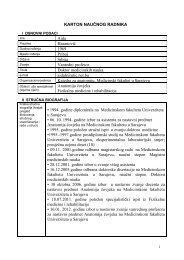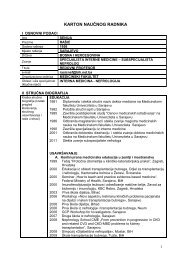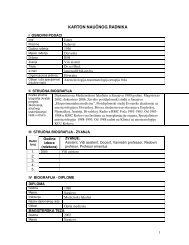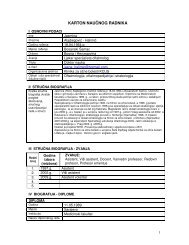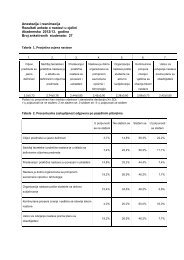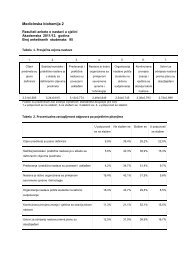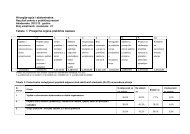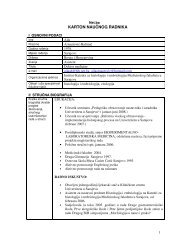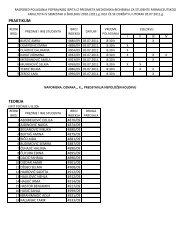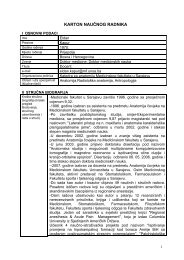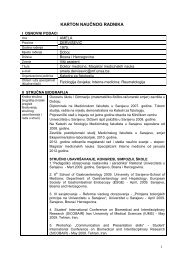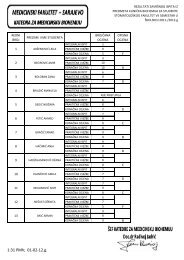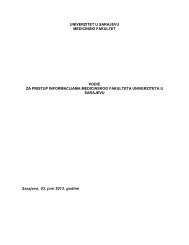Contents - Medicinski Fakultet u Sarajevu - University of Sarajevo
Contents - Medicinski Fakultet u Sarajevu - University of Sarajevo
Contents - Medicinski Fakultet u Sarajevu - University of Sarajevo
Create successful ePaper yourself
Turn your PDF publications into a flip-book with our unique Google optimized e-Paper software.
Folia Medica 2011; 46 No 1:41-47IntroductionCytokines are low level-molecular proteinssecreted by wide spectrum <strong>of</strong> cells and includedin the mediation and the regulation<strong>of</strong> non-specific and specific acquired immuneresponse. Their function is connectionto specific receptors in the membrane <strong>of</strong>target cells which induce signal pathways viaother mediators, <strong>of</strong>ten tyrosine kinase, andleads to change in the expression <strong>of</strong> genesencode the functions and the behaviour <strong>of</strong>cells (1). On the basis dominant biologicalactivity in the toxoplasma infection, theycan be divided into 2 main types: protectiveand regulatory cytokines (2). T. gondii infectionis strong trigger <strong>of</strong> natural immunitywith non-specific activation <strong>of</strong> macrophagesand along with other hematopoietic andnon-hematopoietic cells (3). They produceIL 12 that then activates NK and T cells tosecrete IFN-γ which early burst is crucial inshaping <strong>of</strong> resistance to this infection. IFN-γsynergizes with TNF-α in mediating to killT. gondii tachyzoites by macrophage microbicidalfunction (4). Combination <strong>of</strong> theseboth cytokines leads to production <strong>of</strong> reactivenitrogen intermediates which are capable<strong>of</strong> reducing parasite proliferation.Non-specific immune response leadsto differentiation <strong>of</strong> macrophages and Blymphocytes into APC. T lymphocytes arestimulated by APC presenting specific antigento TCR (T cell receptor) (5). This resultsin the Th1 differentiation <strong>of</strong> CD4+ TLwith production protective cytokines IFN-γand IL 2, and also Th2 differentiation withproduction regulatory cytokines IL 4, IL 5,IL 6 and IL 10. These cytokines synergeticpromote the regulation <strong>of</strong> the protectiveimmunity (6,7,8). CD8+ TLs, activated byIL 2 from Th1 type cells, show cytotoxicactivity against parasite and infected cells.Finally, the control <strong>of</strong> this infection is resultedby synergetic action between CD4+and CD 8+ TL (9). Acute phase <strong>of</strong> infectionis characterized by high levels <strong>of</strong> IFN-γ andproinflammatory cytokine, but also <strong>of</strong> synthesis<strong>of</strong> IL 10 to avoid an excessively strongcell mediated immunity and then to allowthe parasite to survive and establish chronicinfection (10). Chronic phase <strong>of</strong> infection ischaracterized by decrease <strong>of</strong> level <strong>of</strong> IFN-γand proinflammatory cytokines, while thelevel <strong>of</strong> IL 10 rises (11). Most <strong>of</strong> the datain the field <strong>of</strong> immunity <strong>of</strong> Toxoplasma infectionhave been obtained from studies inanimals, in particular, in mice. Although,the mice model represents a vast spectrum<strong>of</strong> immune response related to controlledvariation <strong>of</strong> the genetic background, in essence,these data acquired in animals cannotbe directly applied to humans. The aim <strong>of</strong>this research is to measure and analyze thelevel <strong>of</strong> cytokines (IFN-γ, TNF-α and IL 10).Material and methodsThis research was clinical-experimentalstudy and involved experimental and controlgroup. First group <strong>of</strong> subjects was representedby 40 patients seropositive to T.gondii, out <strong>of</strong> which 26 patients had acutetoxoplasma infection and 14 had chronictoxoplasma infection. Second group consisted<strong>of</strong> 30 subjects seronegative to T. gondii.Their serums were tested for the presenceand concentration <strong>of</strong> specific cytokines(IFN-γ, TNF-α and IL10). This survey wasconducted at Institute for Microbiology andpathology <strong>of</strong> the <strong>University</strong> Clinical CenterTuzla during 2007.The level <strong>of</strong> mentioned cytokines wasverified by the Elisa test (enzyme-linked immunosorbentassay) using commercial kits:IFN-γ-EASIA (Biosource Europe S.A, Nivelles,Belgium), Human TNF-α/TNFSF1A(R&D Systems Inc, Minneapolis, USA) andHuman IL-10 (R&D Systems Inc, Minneapolis,USA). The plates with the samples, standardsand controls were examined at 450nmin the «Metertech 960» reader during 3042



